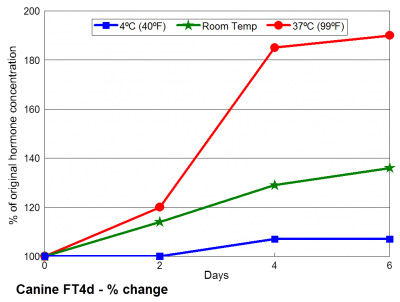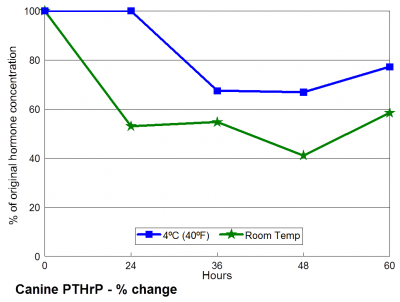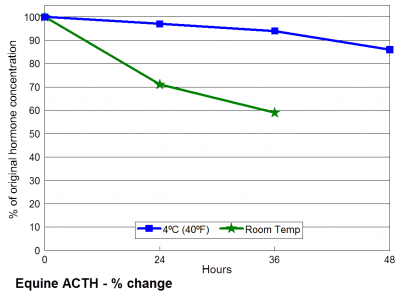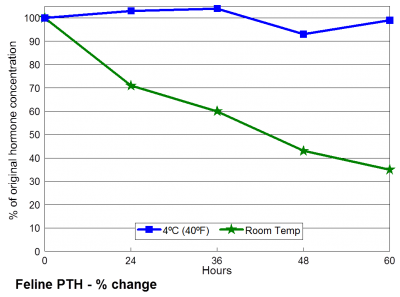What to Expect when a Sample Arrives at the Laboratory “Too Warm”
We can expect delayed transit or warming of serum/plasma samples to cause problems with some of the tests we run. In particular, warm temperatures can cause problems with endogenous (plasma) ACTH, Parathyroid hormone (PTH), Parathyroid hormone related protein (PTHrP), and Free T4 by equilibrium dialysis (FT4d; part of our “Premium” thyroid profiles). With the exception of FT4d, the results we obtain from a warm sample will be lower than those we would have obtained if the sample arrived under ideal circumstances. FT4d results are increased in samples that are delayed or warm on arrival.
Should you request a “too warm” sample be run anyway?
This is going to depend on many factors. For example, how long was the transit time? How difficult was the sample to obtain? Can a replacement be easily obtained? How much does it cost to ship? What are the clinical circumstances you are investigating? Often a result from a “too warm” sample is still clinically useful but, unfortunately, we can't know whether it is until after we perform the analysis and have the result. This means that by requesting an analysis on a “too warm” sample you are taking a chance that the result will be interpretable. The possible advantage is that you will have an interpretable result sooner and without the additional expense, inconvenience, and mailing costs of a redraw. The risk, of course, is that the result will not be interpretable and you will have incurred the costs of the analysis in addition to your redraw expenses.
See below for a summary decision table and more detailed information by analyte and diagnostic circumstance:
-
Analyte
You may consider “taking a chance” if sample was submitted:
Cancel ± resubmit if sample was submitted:
-
ACTHto differentiate hyperadrenocorticism to support primary hypoadrenocorticism for equine pituitary adenoma diagnosiswhen adrenal neoplasia is already a strong possibility (e.g. previous dexamethasone suppression test failed to differentiate) to support pituitary ACTH deficiency
-
PTHfrom an older hypercalcemic dog or cat from an azotemic patient (primary vs secondary hyperparathyroidism)from young hypercalcemic dogs from hypocalcemic patients (no azotemia, no GI disease) to monitor calcitriol
-
PTHrPfrom a hypercalcemic dog with suspected lymphoma or anal apocrine gland neoplasia from a hypercalcemic cat with massfor research purposes
-
FT4das part of a larger panelas a stand-alone test or for OFA certification with previous evidence of T4 antibodies
Observed Changes in Hormone Measurements at Different Shipping Temperatures






Endogenous ACTH
Knowing that the result you would have obtained under ideal circumstances would have been higher than the result in your “too warm” sample can be useful to you. If you get an ACTH result that is mid-normal or higher, you will still be able to determine that there is pituitary-dependent disease when you are trying to differentiate the source of hyperadrenocorticism. Similarly, high ACTH results from “too-warm” samples could still support primary hypoadrenocorticism or equine pituitary pars intermedia dysfunction.
Low results from “too-warm” samples are generally not interpretable. A low value could be either physiological (e.g. canine adrenal neoplasia, true-negative equine pituitary adenoma) or indeed may just reflect deterioration of the sample. In situations where you are “looking for” or expecting a low value, or need one to provide a diagnostic answer, it is usually best to resubmit (e.g., when a high-dose dexamethasone suppression test has previously failed to suppress cortisol sufficiently to allow you to differentiate a case of hyperadrenocorticism).
Parathyroid Hormone
In general terms, canine PTH is not as sensitive to improper handling as ACTH, and “too-warm” sample results are likely to reflect the true concentration particularly if the sample has been in the mail for less than 36 hours (see chart). When degradation does occur, the “real” result would have been higher than that obtained from a “too-warm” sample. Therefore, high results could still support diagnoses of secondary and primary hyperparathyroidism in dogs and cats, and values greater than ~2 pmol/L (with our current assay) would still support primary hyperparathyroidism in a hypercalcemic dog. Bear in mind that primary hyperparathyroidism is usually a disease of middle-aged and geriatric animals (usually > 7 years of age), and that renal secondary hyperparathyroidism would not be expected in the absence of azotemia. This means that it would be better to resubmit a fresh sample from young, nonazotemic dogs because we would not expect a high test result from these cases. Similarly, it would be wise to resubmit a fresh sample from hypocalcemic animals suspected of having primary hypoparathyroidism, because you are expecting a low value to confirm your diagnosis.
Parathyroid Related Protein (PTHrP)
This protein is detected in the plasma of some patients with humoral hypercalcemia of malignancy (HHM). The “real” result would have been higher than that obtained from a “too-warm” sample. Therefore, positive (>1 pmol/L) results still provide support for the presence of a PTHrP-mediated hypercalcemia of malignancy. Negative results may be true-negatives (many humoral hypercalcemias are not mediated through PTHrP, including the majority of canine hypercalcemic lymphomas), or may be a reflection of degradation of the protein in transit. PTHrP is more sensitive to improper handling than is PTH, but fortunately we can often tell from the pattern of intact PTH and ionized calcium results whether HHM is a likely diagnosis. Fresh samples should be re-submitted in cases where a positive PTHrP result is an important contribution to your diagnosis or when you are requesting the test for research purposes.
Free T4 by Dialysis (FT4d)
Ideal shipping for this analyte requires that the sample be in transit for less than 48 hours, and that it be less than 60ºF on arrival. Samples that are in the mail longer or are warmer than 60ºF can still be analyzed. However, the FT4 by dialysis result may be higher than it would have been under ideal circumstances. This modest elevation in FT4 by dialysis is unlikely to adversely affect interpretation when it is part of a large thyroid diagnostic panel (e.g. Canine Thyroid Diagnostic Panel) because there are other parameters in that panel on which to base an interpretative judgment. However, when a sample is submitted for FT4d alone, the shipping requirements must be met.
Avoiding the problem
Particularly during summer months, it can be difficult to keep a sample cold overnight in a delivery package. We recommend using the MSU VDL insulated mailer with UPS overnight delivery or a thick walled Styrofoam container with 2 or 3 frozen gel packs (~1 kg) or dry ice in addition to newspaper or other insulation material (bubble wrap) to stand the best chance of getting a cold sample to us. Regular ice or plain paper/cardboard packaging will not keep the sample cold. In particularly warm weather, it might be prudent to keep an aliquot of any clinically critical samples frozen at your premises until you know whether a valid result has been obtained from the sample you mailed.
To discuss an individual case, feel free to call us at 517.353.1683 and ask to speak with the endocrinologist on duty.
